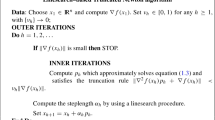Abstract
In this paper we discuss two Newton-type algorithms for solving economic models. The models are preprocessed by reordering the equations in order to minimize the dimension of the simultaneous block. The solution algorithms are then applied to this block. The algorithms evaluate numerically, as required, selected columns of the Jacobian of the simultaneous part. Provisions also exist for similar systems to be solved, if possible, without actually reinitialising the Jacobian. One of the algorithms also uses the Broyden update to improve the Jacobian. Global convergence is maintained by an Armijo-type stepsize strategy.
The global and local convergence of the quasi-Newton algorithm is discussed. A novel result is established for convergence under relaxed descent directions and relating the achievement of unit stepsizes to the accuracy of the Jacobian approximation. Furthermore, a simple derivation of the Dennis-Moré characterisation of the Q-superlinear convergence rate is given.
The model equation reordering algorithm is also described. The model is reordered to define heart and loop variables. This is also applied recursively to the subgraph formed by the loop variables to reduce the total number of above diagonal elements in the Jacobian of the complete system. The extension of the solution algorithms to consistent expectations are discussed. The algorithms are compared with Gauss-Seidel SOR algorithms using the USA and Spanish models of the OECD Interlink system.
Similar content being viewed by others
References
J.E. Dennis Jr. and J.J. Moré, A characterisation of superlinear convergence and its application to quasi-Newton methods, Math. Comp. 28 (1974) 549.
J.E. Dennis Jr. and R.B. Schnabel,Numerical Methods for Unconstrained Optimization and Nonlinear Equations (Prentice-Hall, NJ, 1983).
I.S. Duff, On algorithms for obtaining a maximum transversal, ACM Trans. Math. Software 7 (1981) 315 and 387.
I.S. Duff and J.K. Reid, An implementation of Tarjan's algorithm for the block triangularisation of a matrix, ACM Trans. Math. Software 4 (1978) 137 and 189.
F.J. Henk Don and G.M. Gallo, Solving large sparse systems of equations in econometric models, J. Forecasting 6 (1987) 167.
D. Gabay, P. Nepomiastchy, M. Rachdi and A. Ravelli, Numerical methods for the simulation and optimal control of large-scale macroeconomic models, in:Applied Stochastic Control in Econometrics and Management Science, eds. A. Bensoussan, P. Kleindorfer and C. Tapiero (North-Holland, Amsterdam, 1980).
A.J. Hughes Hallett and P.G. Fisher, On economic structures and model solution methods: Should econometricians use Newton methods for model solution, Oxford Bull. Econ. Statist. 52 (1990) 317.
A.J. Hughes Hallett, Multiparameter extrapolations and deflation methods for solving equation systems, Int. J. Math. Math. Sci. 7 (1984) 793.
H. Levy and D.W. Low, A contraction algorithm for finding small cycle cutsets, J. Algo. 9 (1988) 470.
G. Li, Successive column correction algorithms for solving sparse nonlinear systems of equations, Math. Progr. 43 (1989) 187.
J.J. Moré and J.A. Trangenstein, On the global convergence of Broyden's method, Math. Comp. 30 (1976) 523.
P. Nepomiastchi and A. Ravelli, Adapted methods for solving and optimizing quasi-triangular models, Ann. Econ. Social Measurement 6 (1978) 555.
A.L. Norman, L.S. Lasdon and J.K. Hsin, A comparison of methods for solving and optimizing a large non-linear macroeconomic model, J. Econ. Dynamics Contr. 6 (1983) 3.
OECD, Interlink Model Manual, Paris, France (1989).
J. Ortega,Numerical Analysis: A Second Course (Academic Press, New York and London, 1972).
J. Ortega and W.C. Rheinboldt,Iterative Solution of Nonlinear Equations in Several Variables (Academic Press, New York and London, 1970).
B. Rustem and M. Zarrop, A quasi-Newton algorithm for the control of large nonlinear econometric models, Large Scale Syst. 2 (1981) 105–111.
R. Tarjan, Depth first search and linear graph algorithms, SIAM J. Comp. 1 (1982) 146.
Author information
Authors and Affiliations
Rights and permissions
About this article
Cite this article
Becker, R., Rustem, B. Algorithms for solving nonlinear dynamic decision models. Ann Oper Res 44, 115–142 (1993). https://doi.org/10.1007/BF02061063
Issue Date:
DOI: https://doi.org/10.1007/BF02061063




